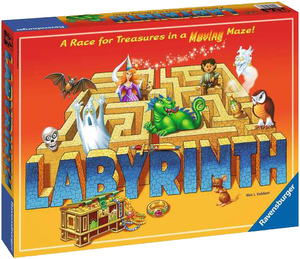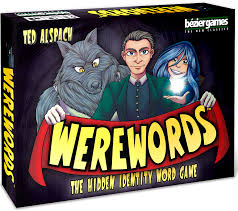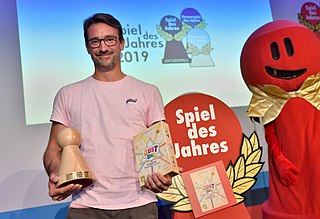
Top Secret Spies (German: Heimlich & Co.) is a spy-themed German-style board game designed by Wolfgang Kramer and published in 1984 by Ravensburger. The game, also known as Under Cover or Detective & Co, won the Spiel des Jahres award in 1986.

Top Secret Spies (German: Heimlich & Co.) is a spy-themed German-style board game designed by Wolfgang Kramer and published in 1984 by Ravensburger. The game, also known as Under Cover or Detective & Co, won the Spiel des Jahres award in 1986.
The object of the game is to score the most points, while not revealing which colour you are until the end. It requires good bluffing and analytical skills. 7 colours are used, and there can be up to 4 "robot" colours moving around. On their turn a player rolls a die and can move any number of pieces a total number of spaces that adds up to the number on the die. This can result in a score, and the game continues until one player reaches 129+ points. At this time all players make secret guesses as to which player is which colour (gaining +5 points at the end of the game for each correct answer). The game ends when a spy reaches 142+ points, and then a winner is determined after guess points are added.
Upon its release the game won the Spiel des Jahres award in 1986. [1] It is remembered in part as the first game to feature a score track encircling the board, now a common feature in many games, as well as the game that introduced thin wooden human-shaped gaming pieces (meeples). [2] In a 1990 interview, Kramer revealed that Heimlich & Co. was not one of his personal favourites. [3]

Carrom is a tabletop game of Indian origin in which players flick discs, attempting to knock them to the corners of the board. In South Asia, many clubs and cafés hold regular tournaments. Carrom is commonly played by families, including children, and at social functions. Different standards and rules exist in different areas.

Torres is a German-style board game designed by Wolfgang Kramer and Michael Kiesling and published in 1999 by FX Schmid in German and by Rio Grande Games in English. The game strongly influenced Kramer and Kiesling's Mask Trilogy of games, but is not considered to be a part of the trilogy. The game has since been reprinted.

El Grande is a German-style board game for 2-5 players, designed by Wolfgang Kramer and Richard Ulrich, and published in 1995 by Hans im Glück in German, by Rio Grande Games in English, and by 999 Games in Dutch. The game board represents renaissance-era Spain where the nobility fight for control of the nine regions. El Grande was praised for its area-control mechanism, and was awarded the Spiel des Jahres prize and the Deutscher Spiele Preis in 1996. Following its release, several expansions and an alternative version were published.
Villa Paletti is a board game of physical skill designed by Bill Payne and published in 2001 by Zoch Verlag. Players compete to build the villa highest using columns from lower floors without collapsing the structure.
This page lists board and card games, wargames, miniatures games, and tabletop role-playing games published in 1986. For video games, see 1986 in video gaming.

Alhambra is a 2003 tile-based German-style board game designed by Dirk Henn. It was originally published in Germany by Queen Games in a language-interdependent version; an English-specific version was released in North America by the now-defunct Überplay. The game is a Muslim-themed update, set during the construction of the Alhambra palace in 14th century Granada, of the 1998 stock trading board game Stimmt So!, which in turn was an update of the 1992 mafia influence board game Al Capone; the original version was subsequently released as Alhambra: The Card Game. Upon its release, Alhambra won numerous awards, including the Spiel des Jahres award. Its success has led to the release of numerous expansion packs and spin-off games, and is becoming Queen Games' flagship franchise.

Barbarossa is a plasticine-shaping German-style board game for 3 to 6 players, designed by Klaus Teuber who based it off The Riddle-Master trilogy by Patricia A. McKillip, it was published in 1988 by Kosmos in German and by Rio Grande Games in English. Barbarossa won the 1988 Spiel des Jahres award.

Wolfgang Kramer is a German board game designer.

Tikal is a German-style board game designed by Wolfgang Kramer and Michael Kiesling and published in 1999 by Ravensburger in German and by Rio Grande Games in English. Set in a Central American jungle, in Tikal players aim to discover artifacts, excavate, and maintain temple control to gain victory points.

Labyrinth is a board game for two to four players, published by Ravensburger in 1986.

Niagara is a German-style board game designed by Thomas Liesching and published in 2004 by Zoch Verlag and Rio Grande Games. In Niagara, which is set in the Niagara Falls, players collect, transport, and steal gems. Upon its release, the game won several awards, including the 2005 Spiel des Jahres.

Ingenious is the English name for Einfach Genial, a German abstract strategy board game designed by Reiner Knizia under commission from Sophisticated Games and published in 2004 by Kosmos. Across most of Europe it is titled as the local translation of Ingenious or Simply Ingenious, the notable exception being Mensa Connections in the UK.

Michael Kiesling is a German board game designer. Many of his games have been nominated for or have won the Spiel des Jahres, a German games award.

Die Macher is a strategy board game published by Hans im Glück in 1986 that simulates a German general election.
Manhattan is a board game designed by Andreas Seyfarth. In the game, players aim to construct and control skyscrapers that will award points. Manhattan received generally positive reviews and won the 1994 Spiel des Jahres award.
6 nimmt! / Take 6! is a card game for 2–10 players designed by Wolfgang Kramer in 1994 and published by Amigo Spiele. The French version is distributed by Gigamic. This game received the Deutscher Spiele Preis award in 1994.

Dixit, is a French board game created by Jean-Louis Roubira, illustrated by Marie Cardouat, and published by Libellud. Using a set of cards illustrated with dreamlike images, players select cards that match a title suggested by the designated storyteller player, and attempt to guess which card the storyteller selected. The game was introduced in 2008. Dixit won the 2010 Spiel des Jahres award.

Werewords is a board game for 4 to 10 players designed by Ted Alspach and published by Bézier Games in 2017. Players guess a secret word by asking questions. There are different roles randomly assigned at the start of play. Villagers try to find out the magic word before the time is up while the werewolves are trying to mislead them.

Just One is a cooperative party game for 3 to 7 players, designed by Ludovic Roudy and Bruno Sautter and published by Repos Production in 2018. In each round of the game, players write down a one word clue for the round's guesser, who must figure out the secret word for the round. Identical clues are discarded before the guesser sees them.

Metro is a board game by Dirk Henn, for 2 to 6 players.